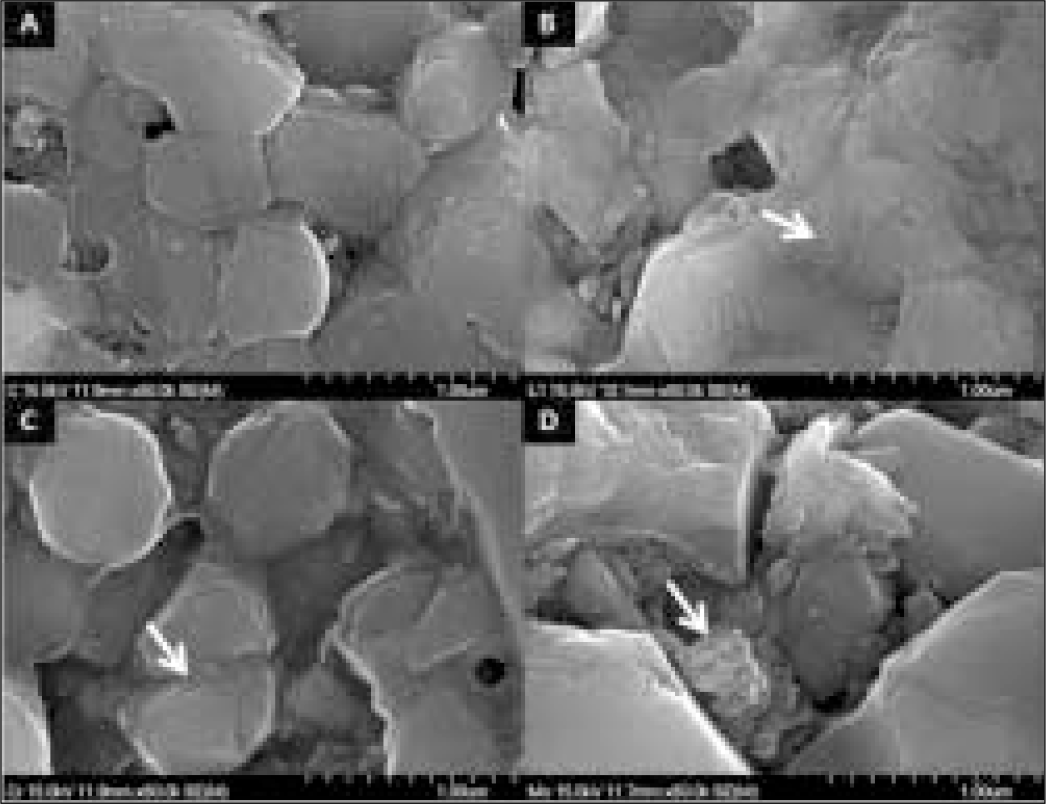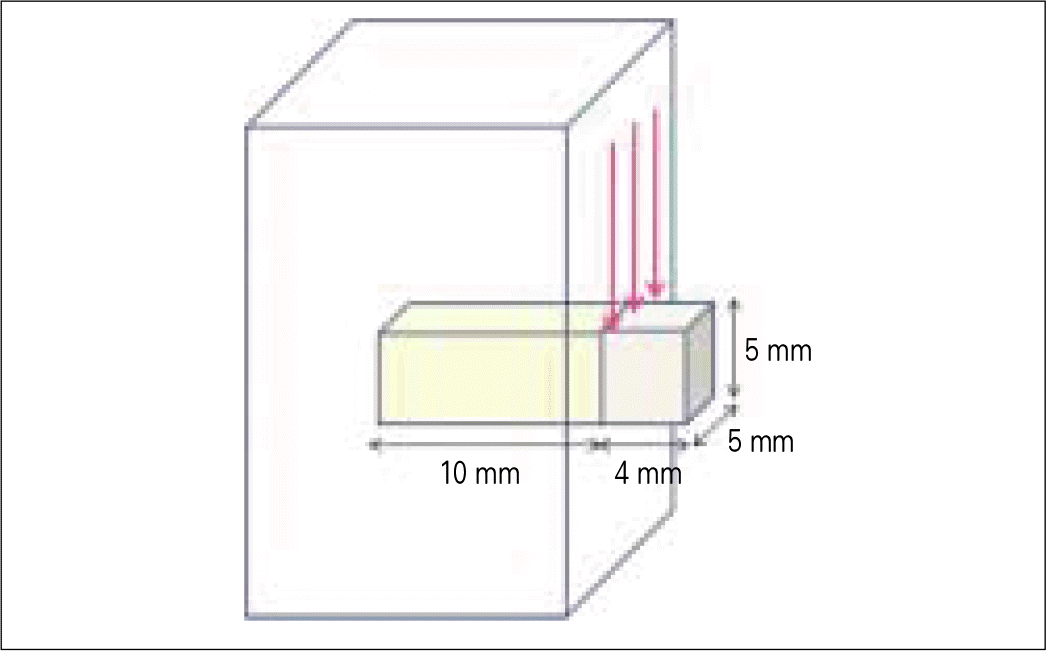Abstract
Purpose
The purposes of this study was to evaluates shear bond strength between zirconia core and veneer-ceramic in order to examine the clinical practice of colored zirconia block fabricated by infiltration method into the metal chloride solution.
Material and methods
CNU block and Everest® ZS blank were used. VITA In-Ceram®2000 YZ Coloring liquid (LL1) and 3 aqueous metal chloride solutions containing chromium and molybdenum ingredients were used. 40 zirconia specimens were prepared into cuboid shape (5 × 5 × 10 mm). All specimens were divided into 5 groups by infiltrating into the coloring liquids. After that, porcelain was build up into the shape of 5 × 5 × 4 mm3, followed by sintering. The maximum loading and shear bond strength was measured. Failure patterns and failure sites were examined.
Results
1. There were no statistical differences in shear bond strength between zirconia blocks (P > .05). 2. There were no statistically significant differences in shear bond strength between non-colored and colored zirconia blocks, while shear bond strength of non-colored zirconia blocks is higher than that of colored specimen (P > .05). 3. In the comparison with shear bond strength among colored zirconia blocks, there were no statistical differences according to kinds of coloring liquid (P > .05). 4. Mixed failure patterns were mainly observed in the failure between zirconia and veneering ceramic. The veneering ceramic failure of all specimens was observed in either interface of zirconia or veneering ceramic.
Go to : 
REFERENCES
1.Piconi C., Maccauro G. Review zirconia as a ceramic biomaterial. Biomaterials. 1999. 20:1–25.
2.Guazzato M., Albakry M., Ringer SP., Swain MV. Strength, fracture toughness and microstructure of a selection of all-ceramic materials. Part I. Pressable and alumina glass-infiltrated ceramics. Dent Mater. 2004. 20:441–8.

3.Kim JY., Seo BC., Oh HK. Toughness Mechanism and Manufacturing Process of ZrO2 Ceramics. Bull Kor Ceram Soc. 1992. 7:80–8.
4.Standard OC., Sorrell CC. Densification of Zirconia-conventional methods. Key Eng Mater. 1998. 251–300.
5.Wang H., Aboushelib MN., Feilzer AJ. Strength influencing variables on CAD/CAM zirconia frameworks. Dent Mater. 2008. 24:633–8.

6.Meyenberg KH., Luthy H., Scharer P. Zirconia posts: A new all-ceramic concept for nonvital abutment teeth. J Esthet Dent. 1995. 7:73–80.

7.Luthardt R., Weber A., Rudolph H., Schone C., Quaas S., Walter M. Design and production of dental prosthetic restorations: basic research on dental CAD/CAM technology. Int J Comput Dent. 2002. 5:165–76.
8.Wohlwend A., Studer S., Scharer P. The zirconium oxide abutment: An all-ceramic abutment for the esthetic improvement of implant super structures. Quintessence Dent Technol. 1997. 1:63–74.
9.Keith O., Kusy RP., Whitley JQ. Zirconia brackets: an evaluation of morphology and coefficients of friction. Am J Orthod Dentofacial Orthop. 1994. 106:605–14.

10.Denry I., Kelly JR. State of the art of zirconia for dental applications. Dent Mater. 2008. 24:299–307.

11.Sundh A., Sjo ¨gren G. Fracture resistance of all-ceramic zirconia bridges with differing phase stabilizers and quality of sintering. Dent Mater. 2006. 22:778–84.

12.Aboushelib MN., Jager N., Kleverlaan CJ., Feilzer AJ. Microtensile bond strength of different components of core veneered all-ceramic restorations. Dent Mater. 2005. 21:984–91.

13.Heffernan MJ., Aquilino SA., Diaz-Arnold AM., Haselton DR., Stanford CM., Vargas MA. Relative translucency of six all-ceramic systems. PartⅡ: core and venner materials. J Prosthet Dent. 2002. 88:10–5.
14.Braga RR., Ballester RY., Daronch M. Influence of time and adhesive system on the extrusion shear strength between feldspathic porcelain and bovine dentin. Dent Mater. 2000. 16:303–10.

15.Al-Shehri SA., Mohammed H., Wilson CA. Influence of lamination on the flexural strength of a dental castable glass ceramic. J Prosthet Dent. 1996. 76:23–8.

16.Isgro G., Pallav P., van der Zel JM., Feilzer AJ. The influence of the veneering porcelain and different surface treatments on the biaxial flexural strength of a heat-pressed ceramic. J Prosthet Dent. 2003. 90:465–73.
17.De Jager N., Pallav P., Feilzer AJ. The influence of design parameters on the FEA-determined stress distribution in CAD-CAM produced all-ceramic dental crown. Dent Mater. 2005. 21:242–51.
18.Oh GJ. Sintering behavior and mechanical properties of zirconia compacts for dental application. A master' s thesis. Department of Dental Science. Chonnam National University,. 2008.
19.Southan DE., Jorgensen KD. Faulty in porcelain jacket crowns. Aust Dent J. 1972. 17:436–40.
20.Beuer F., Erdelt KJ., Schweiger J., Eichberger M., Gernet W. Flexural strength and coloured and aged zirconia. 2004. IADR; abstract no 0113.
21.Cales B. Colored zirconia ceramics for dental applications. Bioceramics. 1998. 11:591–4.
22.Shah K., Holloway J., Denry IL. Effect of coloring with various metal oxides on the microstructure, color, and flexural strength of 3Y-TZP. J Biomed Mater Res B Appl Biomater. 2008. 87:329–37.

23.Bhushan S., Pober R., Giodano R. Coloration of partially stabilized zirconia. 2005. IADR; abstract no 1775.
24.Craig RG. Mechanical properties in restorative dental materials. 11th ed.New York: Mosby;2002. p. 551–92.
25.Al-Dohan HM., Yaman P., Dennison JB., Razzoog ME., Lang BR. Shear strength of core-veneer interface in bi-layered ceramics. J Prosthet Dent. 2004. 91:349–55.

26.Dundar M., Ozcan M., Comlekoglu E., Gungor MA., Artunc C. Bond strengths of veneering ceramics to reinforced ceramic core materials. Int J Prosthodont. 2005. 18:71–2.
27.Gremillard L., Epicier T., Chevalier J., Fantozzi G. Microstructural study of silica-doped zirconia ceramics. Acta Mater. 2000. 48:4647–52.

28.Mecartney M. Influence of an amorphous second phase on the properties of yttria-stabilized tetragonal zirconia polycrystals (Y-TZP). J Am Ceram Soc. 1987. 70:54–8.

29.Tsubakino H., Nozato R., Hamamoto M. Effect of alumina addition on the tetragonal-to-monoclinic phase transformation in zirconia-3 mol % yttria. J Am Ceram Soc. 1991. 74:440–3.
Go to : 
 | Fig. 2.Stereoscopic microscope images shows fractured surfaces of specimens. A, Cohesive failure; B, Mixed failure (V: veneered ceramic, Zr: zirconia). |
 | Fig. 3.The deposition of colorant was detected in the scanning electron microscope images of zirconia specimens.(arrows) (Original magnification, × 50). A, Uncolored zirconia; B, LL1; C, Aqueous chromium chloride solution; D, Aqueous molybdenum chloride solution. |
Table I.
Chemical composition of ziconia block
| Kavo Everest ZS-Blank® | CN block | |
|---|---|---|
| ZrO2 | 79 - 97% | 94.22% |
| Y2O3 | 3 - 14% | 5.43% |
| Al2O3 | < 0.5% | 0.23% |
| Fe2O3 | No | 0.00% |
| H2O | No | 0.35% |
Table II.
Coloring liquids used in this study
| Coloring liquid | Code |
|---|---|
| VITA In-Ceram® 2000 YZ (LL1) | L |
| Aqueous chromium chloride solution | C |
| Aqueous molybdenum chloride solution | M |
| Aqueous chromium + molybdenum chloride solution | CM |
Table III.
Experimental groups of specimens




 PDF
PDF ePub
ePub Citation
Citation Print
Print



 XML Download
XML Download